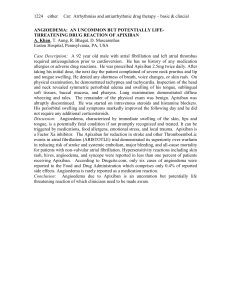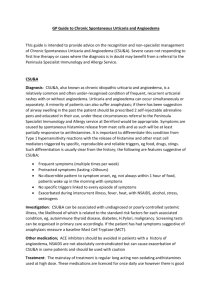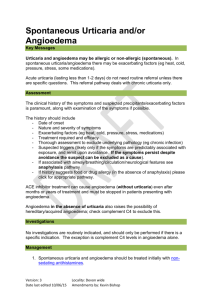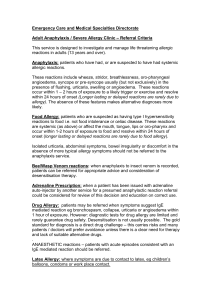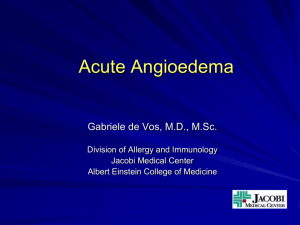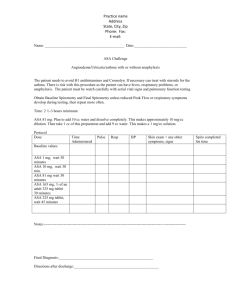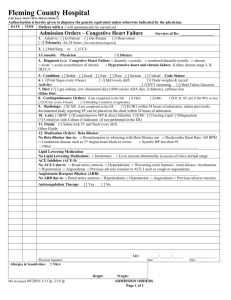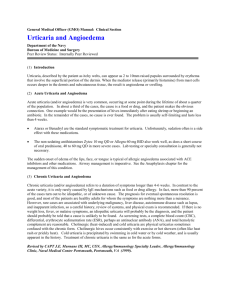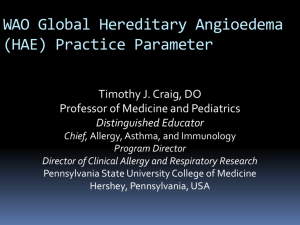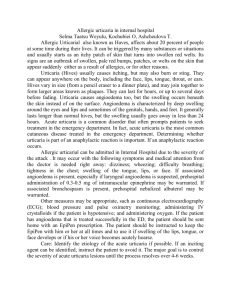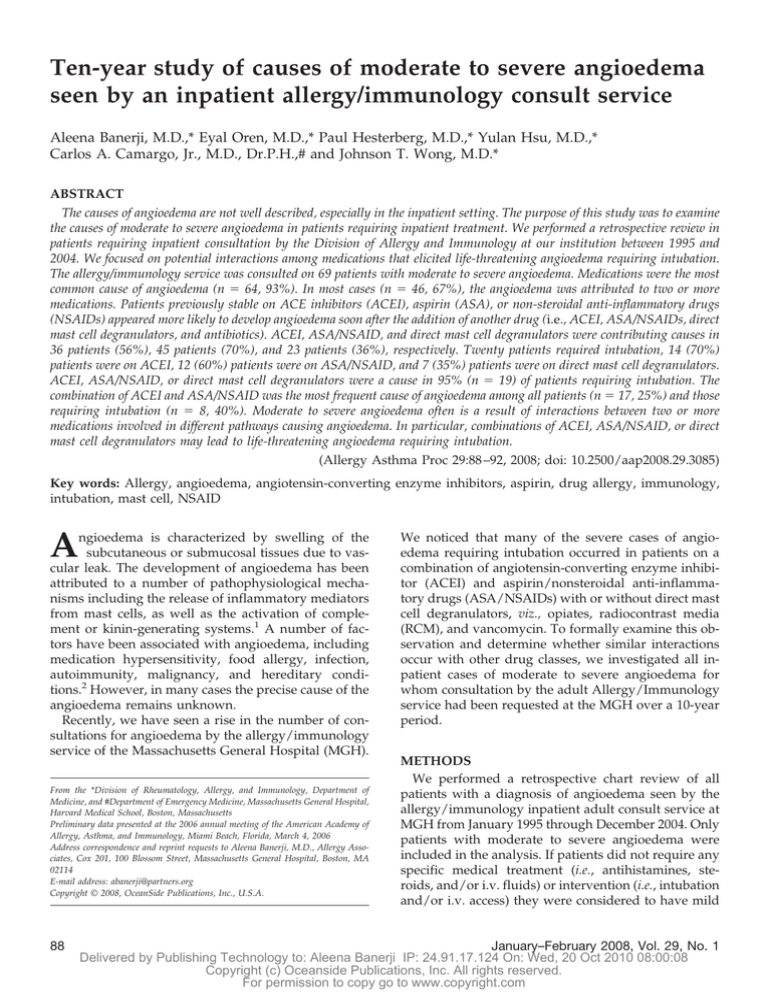
Ten-year study of causes of moderate to severe angioedema
seen by an inpatient allergy/immunology consult service
Aleena Banerji, M.D.,* Eyal Oren, M.D.,* Paul Hesterberg, M.D.,* Yulan Hsu, M.D.,*
Carlos A. Camargo, Jr., M.D., Dr.P.H.,# and Johnson T. Wong, M.D.*
ABSTRACT
The causes of angioedema are not well described, especially in the inpatient setting. The purpose of this study was to examine
the causes of moderate to severe angioedema in patients requiring inpatient treatment. We performed a retrospective review in
patients requiring inpatient consultation by the Division of Allergy and Immunology at our institution between 1995 and
2004. We focused on potential interactions among medications that elicited life-threatening angioedema requiring intubation.
The allergy/immunology service was consulted on 69 patients with moderate to severe angioedema. Medications were the most
common cause of angioedema (n ⫽ 64, 93%). In most cases (n ⫽ 46, 67%), the angioedema was attributed to two or more
medications. Patients previously stable on ACE inhibitors (ACEI), aspirin (ASA), or non-steroidal anti-inflammatory drugs
(NSAIDs) appeared more likely to develop angioedema soon after the addition of another drug (i.e., ACEI, ASA/NSAIDs, direct
mast cell degranulators, and antibiotics). ACEI, ASA/NSAID, and direct mast cell degranulators were contributing causes in
36 patients (56%), 45 patients (70%), and 23 patients (36%), respectively. Twenty patients required intubation, 14 (70%)
patients were on ACEI, 12 (60%) patients were on ASA/NSAID, and 7 (35%) patients were on direct mast cell degranulators.
ACEI, ASA/NSAID, or direct mast cell degranulators were a cause in 95% (n ⫽ 19) of patients requiring intubation. The
combination of ACEI and ASA/NSAID was the most frequent cause of angioedema among all patients (n ⫽ 17, 25%) and those
requiring intubation (n ⫽ 8, 40%). Moderate to severe angioedema often is a result of interactions between two or more
medications involved in different pathways causing angioedema. In particular, combinations of ACEI, ASA/NSAID, or direct
mast cell degranulators may lead to life-threatening angioedema requiring intubation.
(Allergy Asthma Proc 29:88 –92, 2008; doi: 10.2500/aap2008.29.3085)
Key words: Allergy, angioedema, angiotensin-converting enzyme inhibitors, aspirin, drug allergy, immunology,
intubation, mast cell, NSAID
A
ngioedema is characterized by swelling of the
subcutaneous or submucosal tissues due to vascular leak. The development of angioedema has been
attributed to a number of pathophysiological mechanisms including the release of inflammatory mediators
from mast cells, as well as the activation of complement or kinin-generating systems.1 A number of factors have been associated with angioedema, including
medication hypersensitivity, food allergy, infection,
autoimmunity, malignancy, and hereditary conditions.2 However, in many cases the precise cause of the
angioedema remains unknown.
Recently, we have seen a rise in the number of consultations for angioedema by the allergy/immunology
service of the Massachusetts General Hospital (MGH).
From the *Division of Rheumatology, Allergy, and Immunology, Department of
Medicine, and #Department of Emergency Medicine, Massachusetts General Hospital,
Harvard Medical School, Boston, Massachusetts
Preliminary data presented at the 2006 annual meeting of the American Academy of
Allergy, Asthma, and Immunology, Miami Beach, Florida, March 4, 2006
Address correspondence and reprint requests to Aleena Banerji, M.D., Allergy Associates, Cox 201, 100 Blossom Street, Massachusetts General Hospital, Boston, MA
02114
E-mail address: abanerji@partners.org
Copyright © 2008, OceanSide Publications, Inc., U.S.A.
88
We noticed that many of the severe cases of angioedema requiring intubation occurred in patients on a
combination of angiotensin-converting enzyme inhibitor (ACEI) and aspirin/nonsteroidal anti-inflammatory drugs (ASA/NSAIDs) with or without direct mast
cell degranulators, viz., opiates, radiocontrast media
(RCM), and vancomycin. To formally examine this observation and determine whether similar interactions
occur with other drug classes, we investigated all inpatient cases of moderate to severe angioedema for
whom consultation by the adult Allergy/Immunology
service had been requested at the MGH over a 10-year
period.
METHODS
We performed a retrospective chart review of all
patients with a diagnosis of angioedema seen by the
allergy/immunology inpatient adult consult service at
MGH from January 1995 through December 2004. Only
patients with moderate to severe angioedema were
included in the analysis. If patients did not require any
specific medical treatment (i.e., antihistamines, steroids, and/or i.v. fluids) or intervention (i.e., intubation
and/or i.v. access) they were considered to have mild
January–February 2008, Vol. 29, No. 1
Delivered by Publishing Technology to: Aleena Banerji IP: 24.91.17.124 On: Wed, 20 Oct 2010 08:00:08
Copyright (c) Oceanside Publications, Inc. All rights reserved.
For permission to copy go to www.copyright.com
angioedema and were not included in the analysis. The
Institutional Review Board of the MGH approved the
study.
We compiled information from the patients’ records
including age, sex, race, and concurrent medications.
With regard to the clinical course, we focused on cases
of severe angioedema that required treatment with
epinephrine or intubation. We also noted the duration
of use of causative medication(s) or other contributing
causes as determined by the inpatient allergy/immunology consult service. The service included one allergy/immunology attending and at least one allergy/
immunology fellow-in-training who independently
evaluated the patient and agreeed on the cause of
angioedema at the time of consultation. In particular,
we focused on potential interactions among medications in eliciting life-threatening angioedema requiring
intubation. All cases were evaluated for hereditary and
acquired forms of angioedema via laboratory assays for
complement, C1 inhibitor function/level, and C1q
level, where appropriate. Data are described using descriptive statistics. Data are presented as proportions
(with 95% confidence intervals [CIs]) or means (with
standard deviation [SD]).
RESULTS
Over the 10-year study period, 69 patients with a
diagnosis of moderate to severe angioedema required
inpatient consultations by the allergy/immunology
service. In this population, there was a female predominance with 43 (62%) women and 26 (38%) men. Ages
ranged from 18 to 92 years with a mean of 61 years
(SD ⫽ 16). A significant proportion of the population
was white (n ⫽ 46, 67%), consistent with the racial/
ethnic mix of patients at our institution. The second
largest group was African American (n ⫽ 14, 20%), and
several patients were of Asian, Hispanic, and Middle
Eastern descent.
In 64 patients (93%), the cause of angioedema was
attributed to medications by the allergist/immunology
consult service. Of the five nonmedication-related
cases (7%), 1 patient was diagnosed with hereditary
angioedema, 3 patients were diagnosed with idiopathic angioedema (with or without urticaria), and 1
patient was diagnosed with angioedema secondary to
hormonal treatment with progesterone. ACEI, ASA/
NSAID, and direct mast cell degranulators were the
most common medications implicated, leading to 37
(58%), 45 (70%), and 23 (36%) of the cases of angioedema, respectively (Fig. 1). Together, these three
groups of medications accounted for 62 (97%) of all
cases of medication associated with moderate to severe
angioedema. Other antibiotics and antineoplastic and
anesthetic agents comprised the other medication-related causes. Of the 64 medication-related cases, 46
Figure 1. Most common causes of moderate to severe angioedema
in the inpatient setting.
were attributed to ⱖ2 medications that have been
known to cause urticaria or angioedema.
Angioedema Requiring Intubation
Twenty (31%; 95% CI, 26 –34%) of the 64 patients
with medication-associated angioedema required intubation. None of the 5 patients with nonmedicationassociated angioedema required intubation. Fourteen
(70%) of the intubated patients were receiving ACEI, 12
(60%) were receiving ASA/NSAID, and 7 (35%) were
receiving an opiate. Of the intubated patients, 6 (30%)
were on concurrent ACEI and ASA/NSAID. Two additional patients were on ACEI and ASA/NSAID, but
one patient in combination with opiates and the other
in combination with an anesthetic. Two (10%) patients
were taking ACEI alone and two (10%) patients were
taking ASA/NSAID alone. Four patients were taking
ACEI with opiates and one patient was on ASA and
opiates. The other three patients were on a combination of Cefepime and Tobramycin, ASA and Levaquin
and vancomycin with opiates. ACEI, ASA/NSAID, or
direct mast cell degranulators alone or in combination
accounted for 95% (n ⫽ 19) of patients requiring intubation. Overall, in 80% (n ⫽ 16) of patients with angioedema requiring intubation for airway protection, the
cause was attributed to more than one drug.
ACEI Angioedema
Of the 64 patients with medication-related angioedema, 37 (58%) were related to ACEI use (in 1 patient,
angioedema followed initiation of an angiotensin receptor blocker [ARB] 2 days after an ACEI was discontinued). Of these 37 patients, 6 (16%) developed angioedema while on treatment with ACEI alone. The
remaining 31 cases (84%) involved a combination of an
ACEI and either ASA/NSAIDs (n ⫽ 23), opiates (n ⫽
12), RCM (n ⫽ 1), or anesthetics (n ⫽ 1). One patient
developed angioedema with a combination of ARB
and ASA.
Fourteen of the patients for whom ACEI was a cause
of angioedema required intubation. Only 2 of the intubated patients were on ACEI alone. The other 12 pa-
Allergy and Asthma Proceedings
Delivered by Publishing Technology to: Aleena Banerji IP: 24.91.17.124 On: Wed, 20 Oct 2010 08:00:08
Copyright (c) Oceanside Publications, Inc. All rights reserved.
For permission to copy go to www.copyright.com
89
Table 1 Cause of moderate to severe angioedema
ACEI
ASA/NSAID
公
公
公
公
公
公
公
公
公
公
Direct Mast Cell
Degranulator
公
公
公
公
tients were on various combinations of ASA/NSAID
(n ⫽ 8, 57% intubated ACEI patients), opiates (n ⫽ 5,
36% of intubated ACEI patients), or anesthetics (n ⫽ 1,
7% of intubated ACEI patients).
Of the 23 patients (36%) who developed angioedema
attributed to concurrent use of an ACEI and ASA/
NSAID, 6 (25%) were started on either ACEI or ASA/
NSAID therapy within 2 weeks of the onset of angioedema. Most of the patients in this category developed
a moderate to severe degree of angioedema involving
the tongue and throat. None of the patients had any
symptoms of flushing, rash, or urticaria if they were
not concurrently on ASA/NSAIDs.
ASA/NSAID Angioedema
There were 45 patients identified who developed
angioedema while on ASA/NSAID therapy. Eleven of
the 45 (24%) patients were on ASA or NSAIDs alone,
while in the remaining 34 (76%) patients, angioedema
was caused by more than one drug in combination
with the ASA/NSAIDs. These 34 patients were on
various combinations of ACEI (n ⫽ 23), opiates (n ⫽
10), RCM (n ⫽ 3), ARB (n ⫽ 1), and anesthetics (n ⫽ 2).
Several of the patients on ASA/NSAIDs also developed urticaria in addition to angioedema.
Twelve (26% of all ASA/NSAID-associated therapy
and 60% of intubated) patients on therapy with ASA/
NSAIDs required intubation. Two of the 12 patients
(17%) were on ASA/NSAIDs alone. The remaining 10
patients (83%) were on ASA/NSAIDs with various
combinations of ACEI (n ⫽ 8, 67%), opiates (n ⫽ 2,
17%), antibiotics (n ⫽ 1, 8%), and anesthetics (n ⫽ 1,
8%).
Direct Mast Cell Activator Angioedema
Opiates comprised the third largest group of medications causing angioedema, identified in 21 (33%) of
the 64 patients in whom medications were the cause of
the angioedema. RCM (n ⫽ 3) and vancomycin (n ⫽ 1)
were much less common causes than opiates. All of the
opiate-associated cases involve various combinations
90
Antibiotic
公
公
Total Patients
% (n)
Intubated Patients
% (n)
27 (17)
16 (11)
10 (7)
9 (6)
7 (5)
6 (4)
4 (3)
3 (2)
30 (6)
10 (2)
20 (4)
10 (2)
5 (1)
5 (1)
5 (1)
N/A
of ACEI (n ⫽ 12), ASA/NSAIDs (n ⫽ 10), antibiotics
(n ⫽ 7), or anesthetics (n ⫽ 1, 5%). There was no case
where opiates were the only suspected causative agent.
Seven patients on opiates required intubation. They
were all concurrently receiving ACEI (n ⫽ 5), ASA/
NSAIDs (n ⫽ 2), or vancomycin (n ⫽ 1).
DISCUSSION
In contrast to the overall population of patients who
develop angioedema, the subgroup with moderate to
severe angioedema requiring inpatient consultation
had a cause identified in ⬎90% of the cases (Table 1).
At our institution, during the 10-year study period, the
most common cause was medication, accounting for
93% (64/69) of the patients. Of the medication-induced
angioedema, the majority of cases were caused by a
combination of medications. Our study found the usually suspected medications, ACEI (56%) and ASA/
NSAIDs (70%), caused a majority of the moderate to
severe angioedema. However, a surprising finding was
that direct mast cell degranulators also contributed to a
significant number of the cases (36%).
ACEIs were the second most common cause of moderate to severe angioedema in our study population,
but the most common cause among patients requiring
intubation. In that respect, our study is consistent with
other studies that have shown ACEIs have become a
common cause of angioedema in the hospital and
emergency department.3– 6 The literature suggests that
the interval between onset of angioedema and duration
of ACEI treatment generally is days to weeks, with
only a minor subgroup occurring up to several years
later.7 In this series, the addition of other medications
capable of causing angioedema, in particular ASA/
NSAIDs and direct mast cell degranulators, appeared
to be relevant in patients who had been previously
stable on an ACEI. This is consistent with previous case
reports that have implicated concurrent medications,
dental surgery, local anesthetics, and interruption of
ACEI therapy as possible triggers for angioedema in
January–February 2008, Vol. 29, No. 1
Delivered by Publishing Technology to: Aleena Banerji IP: 24.91.17.124 On: Wed, 20 Oct 2010 08:00:08
Copyright (c) Oceanside Publications, Inc. All rights reserved.
For permission to copy go to www.copyright.com
patients who have previously tolerated ACEI treatment.8 –13
In this series, most of the angioedema caused by
ACEIs involved the oropharyngeal area and appeared
to be a major contributor toward the severity, with a
disproportionate number requiring intubation. In part,
this reflects the predilection of ACEI-induced angioedema for that area,14 although the reasons for this
predilection remain poorly understood. Patients on
ACEI alone did not have urticaria. However, urticaria
was noted in several patients taking concurrent ASA/
NSAIDs. The numbers were too small to be statistically
significant but suggested that ACEIs alone generally
do not lead to urticaria, similar to hereditary angioedema.
In our study, ASA/NSAIDs was the most common
cause of moderate to severe angioedema and the second most common cause in the subgroup requiring
intubation. ASA/NSAIDs are well-known causes of
angioedema either with or without associated urticaria. ASA/NSAIDs inhibit cyclooxygenase (COX-1
and COX-2) enzymes, thereby decreasing prostaglandin production and causing increased production of
leukotrienes. This may be the dominant mechanism of
ASA/NSAID-induced angioedema/urticaria.15 The incidence is much higher for agents capable of inhibiting
both COX-1 and COX-2 compared with those that specifically inhibit COX-2.
Opiates, RCM, and antibiotics such as vancomycin
cause direct mast cell degranulation and may contribute to angioedema via this mechanism.16 –18 Other antibiotics cause angioedema by direct IgE-mediated
mast cell degranulation. However, there were no patients in this series with angioedema caused by opiates
alone, suggesting that in most cases opiates alone are
inadequate to cause severe angioedema. Our observations suggest that factors influencing different pathways, as described previously, may synergize to induce angioedema in patients that would otherwise not
develop moderate to severe angioedema if only one
pathway was affected.
Our study has several limitations. The first is the
retrospective and single center design. We compiled
10 years of data to yield 69 cases. More importantly,
there are no validated assays for the diagnosis of
medication-induced angioedema. The allergy/immunology consultants performed a comprehensive
history and physical examination including complete home and hospital medication lists. They combined this knowledge with a full understanding of
the current medical literature describing medicationinduced angioedema to determine the likely cause.
Until assays are available for proposed mediators of
medication-induced angioedema (such as aminopeptidase P and dipeptidyl peptidase IV, enzymes
known to be involved in the degradation and inac-
tivation of bradykinin),19,20 we will be unable to
confidently diagnose the cause(s) of angioedema.
This makes our findings of multiple medications as
likely causes of medication-induced angioedema of
more clinical value.
In summary, among cases of moderate to severe
angioedema requiring hospitalization and consultation, our findings suggest that medications are the
most common cause of angioedema. In particular,
ASA/NSAIDs, ACEI, and direct mast cell degranulators are the most common cause of moderate to
severe drug-induced angioedema. The addition of a
second or third drug known to potentiate angioedema (i.e., ASA/NSAIDs, ACEI, and direct mast
cell degranulators) often led to the development of
moderate to severe angioedema in otherwise stable
patients. Therefore, physicians should focus on
ACEI, ASA/NSAID, and direct mast cell degranulators when obtaining a medical history in patients
with moderate to severe angioedema and be aware
of potential interactions.
REFERENCES
1.
2.
3.
4.
5.
6.
7.
8.
9.
10.
11.
12.
Frigas E, and Nzeako UC. Angioedema. pathogenesis, differential diagnosis, and treatment. Clin Rev Allergy Immunol 23:
217–231, 2002.
Weldon D. Differential diagnosis of angioedema. Immunol Allergy Clin North Am 26:603– 613, 2006.
Megerian CA, Arnold JE, and Berger M. Angioedema: 5 years’
experience, with a review of the disorder’s presentation and
treatment. Laryngoscope 102:256 –260, 1992.
Golden WE, Cleves MA, Heard JK, et al. Frequency and recognition of angiotensin-converting enzyme inhibitor-associated
angioneurotic edema. Clin Perform Qual Health Care 1:205–
207, 1993.
Pigman EC, and Scott JL. Angioedema in the emergency department: The impact of angiotensin-converting enzyme inhibitors. Am J Emerg Med 11:350 –354, 1993.
Agah R, Bandi V, and Guntupalli KK. Angioedema: The role of
ACE inhibitors and factors associated with poor clinical outcome. Intensive Care Med 23:793–796, 1997.
Slater EE, Merrill DD, Guess HA, et al. Clinical profile of
angioedema associated with angiotensin converting-enzyme inhibition. JAMA 260:967–970, 1988.
Ogbureke KU, Cruz C, Johnson JV, et al. Perioperative angioedema in a patient on long-term angiotensin-converting enzyme (ACE)-inhibitor therapy. J Oral Maxillofac Surg 54:917–
920, 1996.
Peacock ME, Brennan WA, Strong SL, et al. Angioedema as a
complication in periodontal surgery: Report of a case. J Periodontol. 62:643– 645, 1991.
Sadeghi N, and Panje WR. Life-threatening perioperative angioedema related to angiotensin-converting enzyme inhibitor
therapy. J Otolaryngol 28:354 –356, 1999.
Schiller PI, Messmer SL, Haefeli WE, et al. Angiotensin-converting enzyme inhibitor-induced angioedema: Late onset, irregular course, and potential role of triggers. Allergy 52:432– 435,
1997.
Seymour RA, Thomason JM, and Nolan A. Angiotensin converting enzyme (ACE) inhibitors and their implications for the
dental surgeon. Br Dent J 183:214 –218, 1997.
Allergy and Asthma Proceedings
Delivered by Publishing Technology to: Aleena Banerji IP: 24.91.17.124 On: Wed, 20 Oct 2010 08:00:08
Copyright (c) Oceanside Publications, Inc. All rights reserved.
For permission to copy go to www.copyright.com
91
13.
14.
15.
16.
92
Dyer PD. Late-onset angioedema after interruption of angiotensin converting enzyme inhibitor therapy. J Allergy Clin Immunol 93:947–948, 1994.
Roberts JR, and Wuerz RC. Clinical characteristics of angiotensin-converting enzyme inhibitor-induced angioedema. Ann
Emerg Med 20:555–558, 1991.
Picado C. Mechanisms of aspirin sensitivity. Curr Allergy
Asthma Rep 6:198 –202, 2006.
Peachell PT, and Morcos SK. Effect of radiographic contrast
media on histamine release from human mast cells and basophils. Br J Radiol 71:24 –30, 1998.
17.
18.
19.
20.
Renz C, Lynch J, Thurn J, et al. Histamine release during rapid
vancomycin administration. Inflamm Res 47(suppl 1):S69–S70, 1998.
Barke KE, and Hough LB. Opiates, mast cells and histamine
release. Life Sci 53:1391–1399, 1993.
Lefebvre J, Murphey LJ, Hartert TV, et al. Dipeptidyl peptidase
IV activity in patients with ACE-inhibitor-associated angioedema. Hypertension 39:460 – 464, 2002.
Malde B, Regalado J, and Greenberger PA. Investigation of
angioedema associated with the use of angiotensin-converting
enzyme inhibitors and angiotensin receptor blockers. Ann Allergy Asthma Immunol 98:57– 63, 2007.
e
January–February 2008, Vol. 29, No. 1
Delivered by Publishing Technology to: Aleena Banerji IP: 24.91.17.124 On: Wed, 20 Oct 2010 08:00:08
Copyright (c) Oceanside Publications, Inc. All rights reserved.
For permission to copy go to www.copyright.com

